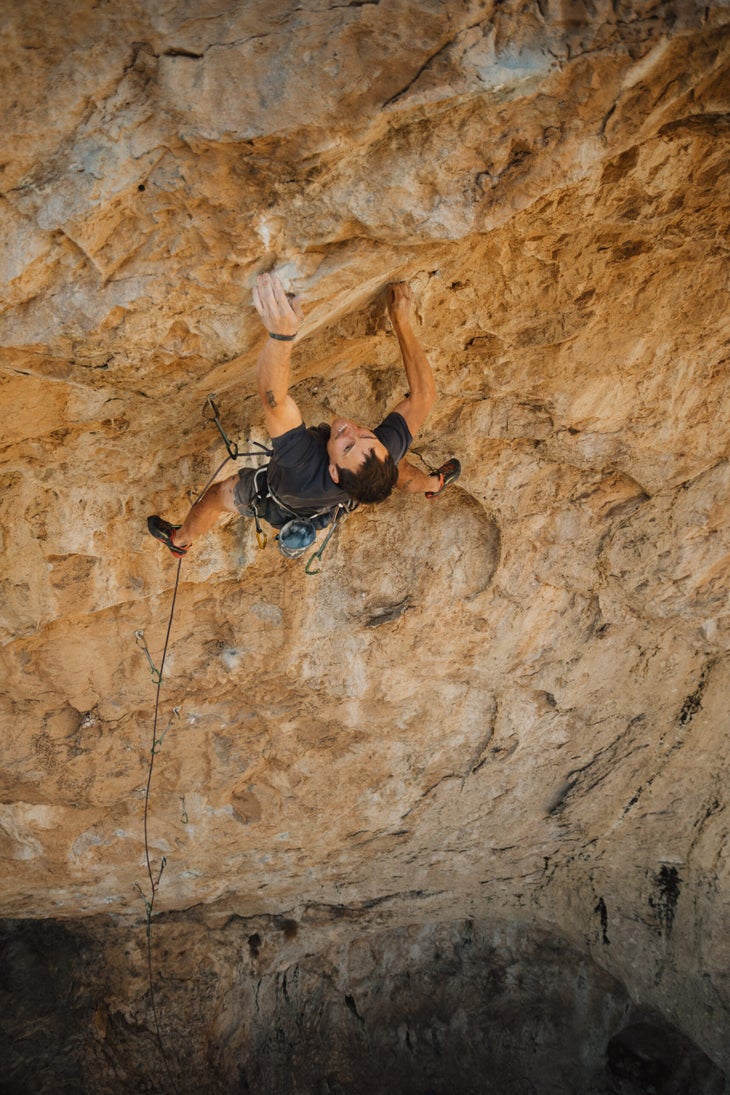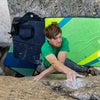Heading out the door? Read this article on the new Outside+ app available now on iOS devices for members! Download the app.
The American West is a blustery place, but this spring was worse than usual for Jonathan Siegrist, who spent three months climbing almost exclusively at “the most consistently windy crag I’ve ever experienced.” His first trip of the year to the Blank Cave in Sunset Alley (one of several stacked sport crags in the Utah Hills west of St. George, Utah) was in mid March, when he checked out two open projects that eventually became True Tiger and The Fury of Wind, both bouldery 5.14c. After that, he bolted a far harder line in the cave and settled in for a siege. The process, he says, involved “looking at the wind, listening to the wind, thinking about the wind, and being blown around daily.” After 20+ days of effort over seven weeks, he clipped the chains on Anemology and graded it 5.15b, making it one of the hardest sport climbs in the United States. The name means “the study of winds.”
According to 8a.nu, Anemology is Siegrist’s 29th 5.15, his sixth 5.15b, and his second 5.15b first ascent, after Event Horizon (2022), which—according to credible rumors—was the hardest climb in the United States until Seb Bouin established Supreme Jumbo Love last year.
Anemology is hard immediately off the ground, Siegrist says. The route’s principal crux is a 16-move sequence (“at least V13, and maybe harder”) through the first four quickdraws. “My first handful of days on the route I didn’t even try the upper part of the climb,” he told Climbing. “I was just trying to make sure that the start was possible.”
After multiple days of work, he finally found a sequence that “seemed to work,” but remained stymied by a very challenging clip at the third bolt. “The fact that the clip is part of the difficulty of the boulder problem is kind of a bummer,” he said. “And I was tempted to start with the third draw stick-clipped. But in the end it was a question of difficulty rather than safety. So I worked on it and managed to clip the draw on the go. And I was really psyched about that.”
After the boulder problem, there’s a kneebar rest, followed by eight more bolts of 5.14+ climbing, including an upper crux that involves moving dynamically on a series of very small crimps through a roof. This, too, took him multiple sessions to unlock—and he never had it 100 percent consistent.

The bottom boulder, however, never even got remotely consistent. Even after he’d linked it through once, there were days when he was fresh and had good conditions but couldn’t make it to the kneebar. “I felt really close to sending my last week on the route,” he said, but he still had days where I just couldn’t do the bottom. With the season winding down, and temperatures creeping upward, Siegrist said he was rather nervous about the outcome, especially since he was foiled by weather late in the projecting process on three separate climbs last year.
Finally, on his fourth successful link of the lower crux, Siegrist managed to hang on through the upper boulder and take it to the top.
Siegrist used kneepads on his ascent, something he tries to be vocal about. He’s well known for eschewing pads whenever possible, particularly when the route was first done without them. But pads were both logical and “absolutely critical” on Anemology. “I don’t think the route would be possible for me without them,” he said.
“I’m a history guy,” Siegrist said, “so if there’s a route that François Legrand did 30 years ago, I personally want to do it in a way that it was originally envisioned. If someone else wants to use a knee pad on it, I think that’s totally fine; everyone should be allowed to climb how they want. But if you use them, you should say so when reporting on the send. Alex Honnold is great at this. He’s doing all these routes up at the Clear Light Cave that never used to be climbed with pads. But he’s saying things like, ‘I used a pad, it’s definitely easier, here’s my opinion on how it affects the grade.’ I give him respect for that. He’s being honest about it.”
Related:
